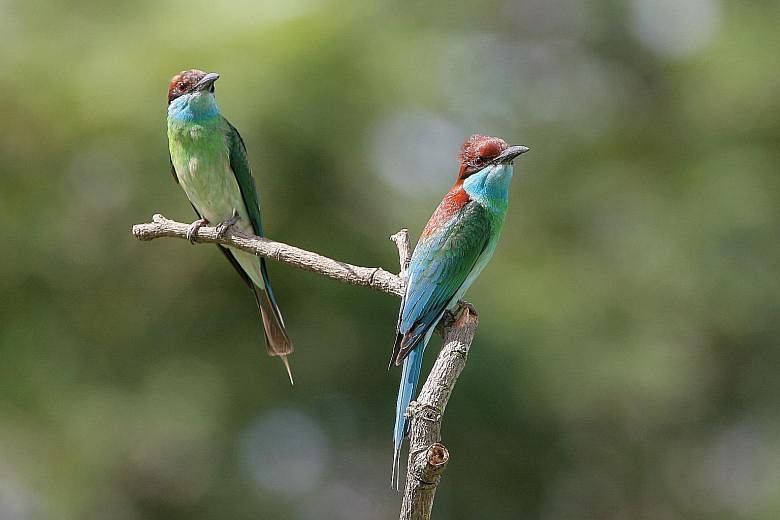More bird species, some of them migratory, are homing in on urban areas, away from their habitats in mangroves and nature reserves.
This is one of the key findings of a five-year bird survey that was published in book form by the National Parks Board (NParks) and launched last week, titled: A Review Of Garden Bird Watch (2015-2019).
NParks' Garden Bird Watch initiative involved trained citizens and lasted from 2015 to last year.
More than 180 bird species were spotted in 64 sites, including nature reserves and urban parks.
By last year, about 1,100 citizens had helped identify and count the birds spotted each year during the breeding season in April and migratory season in November.
The 34 common resident birds, such as the black-naped oriole, Eurasian tree sparrow and pink-necked green pigeon, along with 16 others, showed stable or upward trends in their abundance.
"(Species abundance) is an important benchmark for any ecosystem. Some of them are also related to our efforts in habitat enhancement," said Mr Low Bing Wen, senior manager of NParks' National Biodiversity Centre and one of the book's authors.
Nature parks act as buffers between urban places and nature reserves. As more native plants and insects that birds can feed on are added to urban parks, for instance, the birds start leaving their habitats to colonise these promising new ones, increasing their spread and survival chances.
One example is the malaysian pied fantail, a monochrome bird with a wide tail that spreads out like a Chinese fan. It used to be found only in mangroves and river banks in certain coastal areas.
But as urban wetlands became more common in places such as Bishan-Ang Mo Kio Park, fantails started moving inland through the park connector networks to habitats around Singapore Botanic Gardens and Jurong Lake Gardens.
"The fantails tend not to fly very far, but somehow, when the habitats appear, they find their way to these places," said Mr Low.

-
GET THE BOOKS
-
The two biodiversity books were launched by Minister for National Development Desmond Lee last week.
• A Review Of Garden Bird Watch (2015-2019) can be downloaded for free from the National Parks Board (NParks) website at go.gov.sg/gbwbook Limited hard copy books will be sold at $15 at all Gardens shops in Singapore Botanic Gardens.
• A Guide To The Bees Of Singapore is the nation's first guidebook on bees. It is available in hard copy at $26 at all Gardens shops in Botanic Gardens and through its online shop. The guidebook will reach major bookstores later. Both books will be sold at a 20 per cent discount until Sept 30.
From now to Sept 26, NParks is conducting a BioBlitz, in which participants can identify and record the number of birds, butterflies, bees and dragonflies in parks and gardens of their choice.
Shabana Begum
Sightings of the fantail here increased from four in 2015 to 13 last year.
Since last month, flocks of migratory birds have started landing in the Sungei Buloh Wetland Reserve to escape winter in the Northern Hemisphere. But those few species that fly into urban green spaces are less talked about.
"You are quite likely to see a migratory bird refuelling in a roof garden in your HDB estate," said Mr Low.
The brown shrike, a 20cm-long bird that is indigenous to Russia and China, prefers to take a holiday in grassland and large lawns before journeying to Indonesia.
"Give it another month or so, you might even see one in your neighbourhood primary school soccer field," said Mr Low.
But he noted that although the environment here is conducive to the survival of migratory birds, they may still face threats as they cross over to other regions.
"If the forests in, say, Indonesia continue to shrink and if people in Northern Asia continue to hunt brown shrikes, they will still suffer," he pointed out.
SPOTTED DOVE
Sports a heavily spotted neck patch and is commonly found in neighbourhoods and grass patches. It feeds, either alone or in pairs, on grass seeds, and is popular in the bird trade due to its soothing call. Its local population remains healthy.
Sighted at: Urban areas, gardens, plantations.
BLUE-THROATED BEE-EATER
Has a chestnut brown crown, blue throat and hind, and green plumage. Adults have long tail feathers. The migrant breeder travels to Indonesia from September and returns in April to breed. It is native to South China and South-east Asia
Sighted at: Southern Ridges and other well-wooded parks, Pulau Ubin, Sentosa.
COMMON FLAMEBACK
The most commonly spotted large woodpecker in Singapore, with its signature golden back and crimson red crest. Commonly found in secondary forests and mangroves, the highly adaptable bird is now widespread across the country.
Sighted at: Pasir Ris Park, Coney Island Park, Sungei Buloh Wetland Reserve.
Correction note: In an earlier version of the story, we said about 4,900 citizens had helped identify and count the birds spotted each year during the breeding season in April and migratory season in November. This is incorrect. It should be over 1,100 citizens. We are sorry for the error.




